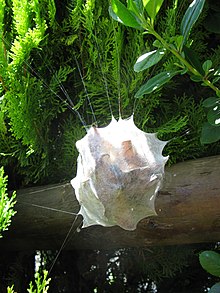Palystes
| Palystes | |
|---|---|

| |
| Female Palystes castaneus near Somerset West, South Africa | |
| Scientific classification | |
| Domain: | Eukaryota |
| Kingdom: | Animalia |
| Phylum: | Arthropoda |
| Subphylum: | Chelicerata |
| Class: | Arachnida |
| Order: | Araneae |
| Infraorder: | Araneomorphae |
| Family: | Sparassidae |
| Genus: | Palystes L. Koch, 1875 |
| Type species | |
| Palystes castaneus Latreille, 1819
| |
| Species | |
|
See text | |
| Diversity[1] | |
| 20 species | |
Palystes is a genus of huntsman spiders, commonly called rain spiders or lizard-eating spiders,[2] occurring in Africa, India, Australia, and the Pacific.[1] The most common and widespread species is P. superciliosus, found in South Africa, home to 12 species in the genus.[1][2] The name Palystes is derived from either the Latin palaestes or the Greek palaistes, meaning "wrestler".[2] The genus was first described by Ludwig Carl Christian Koch in 1875.[1]
Build
Palystes species are large spiders, with a body length of 15–36 mm, and a leg span up to 110 mm. Their top side is covered in tan to dark tan velvety
Habits
While Palystes species mostly hunt insects on plants, they commonly enter houses before rain, or during the summer, where they prey on

The large, round egg sacs of P. castaneus and P. superciliosus are commonly seen from about November to April. After mating in the early summer, the female makes a 60- to 100-mm sac out of silk, with twigs and leaves woven into it. She constructs the sac over 3–5 hours, then aggressively guards it until the spiderlings, which hatch inside the protective sac, chew their way out about three weeks later. Females construct about three of these egg sacs over their two-year lives. Many gardeners are bitten by protective Palystes mothers during this period.[2]
Venom
The size of Palystes spiders, combined with the banding on the underside of the legs exposed when the spider is in threat pose, give them a fearsome appearance.[2][3] An experiment was done in 1959 where a P. superciliosus was allowed to bite an adult guinea pig on the nose. The guinea pig died within 7 minutes, leading to a belief that the spider's venom was dangerous. However, further research on anaesthetized guinea pigs showed that the original guinea pig had actually died of shock, rather than as a result of the spider's venom.[3] In humans a Palystes bite is no more dangerous than a bee sting.[2] It causes a burning sensation, and swelling which lasts for a few days. Recovery is spontaneous and complete.[3]

Wasps
Palystes spiders are also commonly seen
Species
As of November 2022[update] according to The World Spider Catalog, Version 23.5:[1] it contains twenty species
- Palystes ansiedippenaarae Croeser, 1996 — South Africa
- Palystes castaneus Latreille, 1819 — South Africa
- Palystes convexus Strand, 1907 — Madagascar
- Palystes crawshayi Pocock, 1902 — Lesotho
- Palystes ellioti Pocock, 1896 — Central, East Africa
- Palystes fornasinii Pavesi, 1881 — Mozambique
- Palystes hoehneli Simon, 1890 — Kenya, Tanzania
- Palystes johnstoni Pocock, 1896 — Botswana, Zimbabwe, Malawi, Mozambique, Uganda
- Palystes karooensis Croeser, 1996 — South Africa
- Palystes kreutzmanni Jäger & Kunz, 2010 — South Africa[5]
- Palystes leppanae Pocock, 1902 — South Africa
- Palystes leroyorum Croeser, 1996 — South Africa
- Palystes lunatus Pocock, 1896 — South Africa
- Palystes martinfilmeri Croeser, 1996 — South Africa
- Palystes perornatus Pocock, 1900 — South Africa
- Walckenaer, 1805 — New South Wales, New Caledonia
- Palystes reticulatus Rainbow, 1899 — Santa Cruz Islands
- Palystes stilleri Croeser, 1996 — South Africa
- Palystes stuarti Croeser, 1996 — South Africa
- Palystes superciliosus L. Koch, 1875 — Southern Africa
Gallery
-
Female P. superciliosus
-
Underside of female P. superciliosus, showing banding
-
Underside of male P. superciliosus
-
Female P. superciliosus
-
Female P. castaneus
-
Female P. castaneus
-
Female P. castaneus
References
- ^ . Retrieved 19 April 2012.
- ^ a b c d e f g h i Larsen, Norman. "Palystes (rain spiders, lizard-eating spiders)". Biodiversity Explorer. Cape Town, South Africa: Iziko museums. Retrieved 19 April 2012.
- ^ ]
- OCLC 56338396.
- ^ Jäger, P. and D. Kunz. (2010). Palystes kreutzmanni sp. n. – a new huntsman spider species from fynbos vegetation in Western Cape Province, South Africa (Araneae, Sparassidae, Palystinae). ZooKeys 67 1-9.
External links
- Palystes (rain spiders, lizard-eating spiders) on Iziko Museums' Biodiversity Explorer







